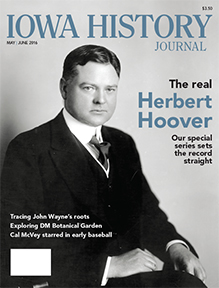(Publisher’s note: Parts 1 and 2 of Iowa History Journal’s special series about Herbert Hoover are devoted to setting the record straight regarding Hoover’s presidency and legacy. Part 3 focuses on Hoover’s Quaker and Iowa roots.)

Iowa native Herbert Hoover served as President of the United States from 1929 to 1933. Photo courtesy of the Herbert Hoover Presidential Library-Museum
By Glen Jeansonne and David Luhrssen
When the economy sank into the Great Recession in 2008, memories of the Great Depression were resurrected and the name “Herbert Hoover” was dusted off for a new round of scolding. He was repeatedly reprimanded as a champion of laissez faire, a term and philosophy he had specifically rejected as early as 1922, in his philosophical treatise, “American Individualism.”
From the right, popular writer Amity Shlaes, author of “The Forgotten Man,” impaled Hoover from the libertarian end of the spectrum. According to Shlaes, Hoover was a co-conspirator with Franklin D. Roosevelt (FDR). The duo prolonged the Great Depression by meddling with the economy. George H. Nash has described Hoover as a political orphan, “Too progressive for the conservatives and too conservative for the liberals.”
Virtually every Democratic presidential candidate since FDR has equated Hoover with hard times. When people think “Depression” they think “Hoover.” They might as well be listed as synonyms in Roget’s Thesaurus.
During his tenure in the White House, Hoover’s once enviable reputation plummeted so precipitously that Will Rogers quipped that a man bit into an apple, found a worm and exclaimed, “Damn Hoover.” Presidential polls of historians as late as 2008 rank him among the worst U.S. presidents and the stereotype cemented in the mind of the general public resembles a cross between Ebenezer Scrooge and the Grinch who stole Christmas. His historical reputation is ensnarled in exaggerations, distortions, factual errors and oversimplifications. He is as much identified with the Great Depression as Isaac Newton is with the Law of Gravity. People who voted against him in 1932 believed things could not possibly get worse. People who voted in Germany that year believed the same thing.
So what is the truth about Hoover? Where does he fit in presidential historiography and why does he remain enmeshed in a maze of myths? Is he a reactionary, a mainstream conservative, a progressive, or is his place on the cutting edge of the New Deal?
Before his presidency, the Iowa native was one of the most admired Americans in the world, an enormously successful mining engineer, humanitarian and philanthropist, gifted administrator, and a rags-to-riches story. Born in West Branch, a Quaker farm village in Iowa of about 400 on the cusp of the frontier, Hoover was the first president born west of the Mississippi River. Orphaned at nine, raised by relatives in Iowa and Oregon, he graduated from the first class of Stanford University with a degree in geology and engineering. At Stanford, he met Lou Henry, the fourth female in America to earn a geology degree, with whom he enjoyed a companionate marriage. Graduating in the midst of the Panic of 1893, he began work as a common laborer at the bottom of a mine shaft. His rise was rapid. His mining assignments took him to the dusty Australian outback and to the far reaches of China, where he survived the Boxer Rebellion under siege at Tientsin in 1900. Based in London, his mining ventures took him to every inhabitable continent and by 1914 he was worth about $4 million, tired of making money and ready for new challenges.
TO READ MORE ABOUT THIS STORY AND OTHER FASCINATING STORIES ABOUT IOWA HISTORY, subscribe to Iowa History Journal. You can also purchase back issues at the store.
